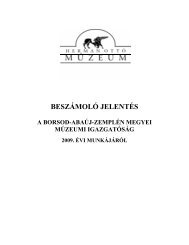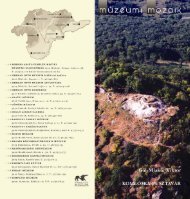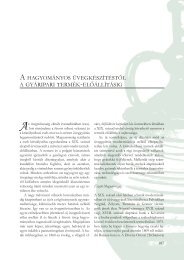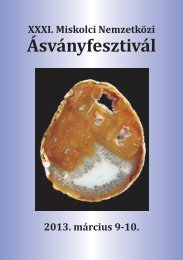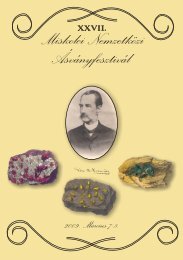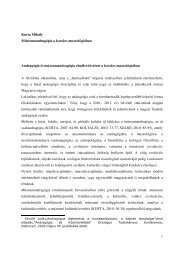Acta Mineralogica-Petrographica, Abstract Series 5, Szeged, 2006NEW DATA ABOUT <strong>THE</strong> <strong>M<strong>IN</strong>ERAL</strong>S OF <strong>THE</strong> COPPER ORE DEPOSIT AT BĂLAN (EAST<strong>CARPATHIANS</strong>) AND OF LIMESTONE XENOLITHS FROM BASALT AT RACOŞU DE JOS(PERŞANI MTS.), ROMANIASZAKÁLL, S. 1 , ALMÁSI, E. 2 , KÖLLŐ, A. 2 , SAJÓ, I. 3 & VEZZAL<strong>IN</strong>I, G. 41 Department of Mineralogy and Petrology, University of Miskolc, H-3515 Miskolc-Egyetemváros, HungaryE-mail: askszs@gold.uni-miskolc.hu2 Department of Geology-Mineralogy, Babeş-Bolyai University, Kogălniceanu str. 1, RO-400084 Cluj-Napoca, Romania3 Chemical Research Centre, Hungarian Academy of Sciences, Pusztaszeri út 59-67, H-1025 Budapest, Hungary4 Dipartimento di Scienze della Terra, Università di Modena e Reggio Emilia, via S. Eufemia 19, I-41100 Modena, ItalyRare secondary sulphates, carbonate-cyanotrichite,slavíkite, fibroferrite from the open pit of the Bălan copperore depositThe Bălan copper ore deposit is hosted in the epimetamorphicTulgheş series. Primary sulphides are dominantpyrite and chalcopyrite, accompanied by sphalerite, galena,tetrahedrite and arsenopyrite. There is an extensive oxidationzone in near-surface position. Common secondary mineralsinclude goethite, malachite, azurite, native copper; cupriteand covelline are rare (POPESCU, 1974; DAVID, 1983).Our investigations were carried out on some secondarymineral parageneses formed in different levels of the FerencFerdinánd open pit. All the minerals mentioned were identifiedby optical, XRD, SEM/EDS and ICP-MS methods.These minerals can be divided into two main groups accordingto the dominant cation, i.e. copper-bearing minerals(formed mainly from chalcopyrite) and iron-bearing ones(formed from pyrite). The main copper-bearing secondaryminerals are chalcanthite, malachite, azurite and brochantite.As a rarity we identified carbonate-cyanotrichite, formingpale blue sprays, up to 1 mm size, in close association withcolourless to blue glass-like allophane encrustation. The mainiron- (and/or magnesium-) bearing secondary sulphates arehalotrichite, pickeringite, fibroferrite and slavíkite. Halotrichiteand pickeringite are found as white to pale yellowish,fine fibrous, hair-like efflorescences, sometimes as globularaggregates. Fibroferrite forms white to pale grey encrustations,which consist of a dense intergrowth of fine fibres.Slavíkite appears as yellowish green to pale green porouscrusts, consisting of, hexagonal tabular crystals, 10-20 µm insize. Carbonate-cyanotrichite, slavíkite and fibroferrite arethe first occurrence reported from Romania.Levyne-Ca and ettringite in limestone xenoliths frombasalt at Racoşu de JosAccording to radiometric age determinations the basaltarea at Racoşu de Jos is one of the youngest in Europe. Thelocality is famous for upper mantle-derived xenoliths consistingmainly of olivine and pyroxene (DOWNES et al., 1995).Quartz xenoliths and contact metamorphic minerals that hasbeen formed at the contact of the xenoliths and the enclosingbasalt were also described from here (MĂLDĂRESCU et al.,1982).In the last years we found rare limestone-derived xenoliths,in which the dominating minerals were Ca silicates. Weexamined these xenoliths by optical, XRD, SEM/EDS andEPMA techniques. They contain high temperature silicateminerals of contact metamorphic origin, mainly gehlenite,diopside and augite. Garnets (andradite–grossular), magnetite,ilmenite, chlorapatite, titanite, and some sulphides appearin smaller amounts.In the cavities and fissures of the limestone xenoliths alow temperature paragenesis of hydrothermal origin occurs.This association contains mainly hydrous Ca silicates, amongthem zeolites, such as levyne and chabazite. Levyne formswhite, hexagonal, tabular crystals up to 0.5 mm in size. Accordingto EPMA results it is levyne-Ca. The other interestinglate-stage mineral is ettringite. It occurs in white needles,some µm across and up to 0.5 mm in length, with hexagonalcross-section or forms fibrous aggregates, in close associationwith levyne-Ca. Ettringite crystals can be hexagonal prismaticto bladed. Ettringite was identified by XRD andSEM/EDS examinations. The three strongest XRD lines are[d (Å) (I rel )]: 9.72 (100), 5.61 (76), 3.87 (31). EDS analysessometimes show chemical compositions close to thaumasitesuggesting an ettringite–thaumasite solid solution in thesecrystals. A few white, globular aggregates up to 0.5 mm,composed of okenite, accompany earlier mentioned minerals.The last precipitations are calcite and smectite. Levyne-Caand ettringite are the first occurrence reported from Romania.ReferencesDAVID, I. (1983): Studiul petrografic şi litografic almetamorfitelor din perimetrul Bălan extindere Nord cuprivire specială asupra mineralizaţiilor de sulfuripolimetalice. University Theses, Manuscript, Babeş–Bolyai University, Cluj-Napoca.DOWNES, H., SEGHEDI, I., SZAKÁCS, A., DOBOSI, G.,JAMES, D.E., VASELLI, O., RIGBY, I.J., REX, D. &PÉCSKAY, Z. (1995): Lithos, 35: 65–81.JASMUND, K. & HENTSCHEL, G. (1964): Beiträge zurMineralogie und Petrographie, 10: 296–314.MĂLDĂRESCU, I., ŞECLĂMAN, M., ATANASIU, M. &BĂDESCU, D. (1982): Analele Universitaţii Bucuresti,Geologie, 33: 21–26.POPESCU, GH. C. (1974): Studiul formaţiunilor cristaline cusulfuri metalice din zona Bălan. Studiu de sinteză.Bucureşti: Ministeriul Minelor, Petrolului şi Geologia.112www.sci.u-szeged.hu/asvanytan/acta.htm
Acta Mineralogica-Petrographica, Abstract Series 5, Szeged, 2006OCCURRENCE OF COWLESITE <strong>IN</strong> ANDESITE AT PILISSZENTLÁSZLÓ, PILIS MTS.,HUNGARYSZAKÁLL, S., 1 FEHÉR, B. 2 & VEZZAL<strong>IN</strong>I, G. 31 Department of Mineralogy and Petrology, University of Miskolc, H-3515 Miskolc-Egyetemváros, HungaryE-mail: askszs@gold.uni-miskolc.hu2 Department of Mineralogy, Herman Ottó Museum, Kossuth u. 13, H-3525 Miskolc, Hungary3 Dipartimento di Scienze della Terra, Università di Modena, via S. Eufemia 19, I-41100 Modena, ItalyCowlesite was first described by WISE & TSCHERNICH(1975) from seven different localities from the U.S.A. Allknown occurrences are in basic lavas. VEZZAL<strong>IN</strong>I et al.(1992) mentioned some localities of cowlesite in basalt fromNorthern Ireland. It was unknown in the Carpathian region todate.There are a few zeolite occurrences in cavities and fissuresof andesite in the Pilis Mts. (NNW from Budapest).Usual zeolite associations in this territory include stilbite,chabazite and heulandite. However, near Pilisszentlászló (inthe Pálbükk quarry) white, soft, spherical aggregates havevery rarely been found in the cavities of the rocks. They consistof very thin radiating plates with pearly lustre. The diameterof the spherules reaches up to 0.5 mm. These spherulesare cowlesite according to XRD patterns and electronmicroprobeanalyses. Cowlesite is often covered by thinsmectite (saponite?) and/or goethite films. In the cavitiessome relatively high temperature rock-forming mineralsoccur in the form of well-developed, but tiny crystals (e.g.plagioclase, amphibole, apatite, magnetite, hematite, andrarely cheralite–monazite). These earlier formed minerals arefollowed by cowlesite, chabazite, smectites, goethite, hematiteand calcite.Cowlesite is a zeolite with unknown structure. Completesingle crystal X-ray study has not been performed so farbecause cowlesite crystals are always very small (up to 0.1mm in width) and thin (up to 2 µm). According to X-raypowder data and very faint precession photographs, cowlesiteis orthorhombic; this symmetry corresponds to the results ofthe optical studies (GOTTARDI & GALLI, 1985).Because of the very limited quantity of available materialfrom the cowlesite from Pilisszentlászló, experimental XRPDpattern was obtained by a 114.6 mm Gandolfi camera usingCoK α radiation. Observed reflections on the X-ray film are [din Å (intensity, hkl)]: 15.15 (vs, 010), 12.44 (w, 001), 8.46(w, 101), 7.64 (vw, 020), 5.68 (w, 121), 4.16 (vw, 202), 3.80(w, 040), 3.45 (vw, 141), 3.27 (vw, 321), 3.12 (w, 004), 3.06(vw, 050), 2.953 (vw, 051), 2.826 (w, 043), and 2.225 (vw,352). Unit cell data calculated from the powder pattern area = 11.46(6) Å, b = 15.19(3) Å, c = 12.45(3) Å, V =2166(12) Å 3 .Electron-microprobe analyses (sample G145) were carriedout in the wavelength-dispersive mode. The results arevery close to those published earlier (WISE &TSCHERNICH, 1975; VEZZAL<strong>IN</strong>I et al., 1992). The data(Table 1) correspond to a composition close to thestoichiometric formula for cowlesite (CaAl 2 Si 3 O 10 • 6H 2 O)and indicate a relatively narrow compositional range. H 2 Ocould not be directly determined due to the paucity of thesample.ReferencesGOTTARDI, G. & GALLI, E. (1985): Natural zeolites. Berlin:Springer-Verlag.VEZZAL<strong>IN</strong>I, G., ARTIOLI, G., QUARTIERI, S. & FOY, H.(1992): Mineralogical Magazine, 56: 575–579.WISE, W.S. & TSCHERNICH, R.W. (1975): AmericanMineralogist, 60: 951–956.Table 1: Chemical composition (in wt%) according to electron-microprobe analyses and corresponding structural formulae forcowlesite from Pilisszentlászló (H 2 O was calculated from difference)No. BaO FeO SrO K 2 O CaO SiO 2 Na 2 O MgO Al 2 O 3 Total1 0.00 0.00 0.05 0.02 11.95 40.99 0.69 0.10 21.67 75.472 0.04 0.02 0.00 0.02 11.15 39.33 0.65 0.09 20.25 71.553 0.05 0.07 0.08 0.09 11.85 41.24 0.92 0.15 22.36 76.814 0.01 0.10 0.01 0.08 11.40 43.59 0.99 0.13 24.77 81.085 0.00 0.06 0.06 0.04 12.17 41.21 0.82 0.14 22.47 76.976 0.00 0.07 0.01 0.08 11.21 40.21 0.76 0.10 19.88 72.327 0.00 0.05 0.00 0.08 11.41 46.04 0.94 0.12 25.24 83.881) (Ca 0.96 Na 0.10 Mg 0.01 ) Σ=1.07 [Al 1.91 Si 3.06 O 10 ] • 6.11H 2 O2) (Ca 0.94 Na 0.10 Mg 0.01 ) Σ=1.05 [Al 1.88 Si 3.09 O 10 ] • 7.45H 2 O3) (Ca 0.93 Na 0.13 Mg 0.02 K 0.01 ) Σ=1.09 [Al 1.94 Si 3.03 O 10 ] • 5.68H 2 O4) (Ca 0.85 Na 0.13 Mg 0.01 Fe 0.01 K 0.01 ) Σ=1.01 [Al 2.02 Si 3.02 O 10 ] • 4.37H 2 O5) (Ca 0.96 Na 0.12 Mg 0.02 ) Σ=1.10 [Al 1.94 Si 3.02 O 10 ] • 5.63H 2 O6) (Ca 0.93 Na 0.11 Mg 0.01 K 0.01 ) Σ=1.06 [Al 1.82 Si 3.13 O 10 ] • 7.19H 2 O7) (Ca 0.81 Na 0.12 Mg 0.01 K 0.01 ) Σ=0.95 [Al 1.98 Si 3.07 O 10 ] • 3.58H 2 Owww.sci.u-szeged.hu/asvanytan/acta.htm 113
- Page 1:
MSCC33 rd MINERAL SCIENCES IN THE C
- Page 5 and 6:
Acta Mineralogica-Petrographica, Ab
- Page 7 and 8:
Acta Mineralogica-Petrographica, Ab
- Page 9 and 10:
Acta Mineralogica-Petrographica, Ab
- Page 11 and 12:
Acta Mineralogica-Petrographica, Ab
- Page 13 and 14:
Acta Mineralogica-Petrographica, Ab
- Page 15 and 16:
Acta Mineralogica-Petrographica, Ab
- Page 17 and 18:
Acta Mineralogica-Petrographica, Ab
- Page 19 and 20:
Acta Mineralogica-Petrographica, Ab
- Page 21 and 22:
Acta Mineralogica-Petrographica, Ab
- Page 23 and 24:
Acta Mineralogica-Petrographica, Ab
- Page 25 and 26:
Acta Mineralogica-Petrographica, Ab
- Page 27 and 28:
Acta Mineralogica-Petrographica, Ab
- Page 29 and 30:
Acta Mineralogica-Petrographica, Ab
- Page 31 and 32:
Acta Mineralogica-Petrographica, Ab
- Page 33 and 34:
Acta Mineralogica-Petrographica, Ab
- Page 35 and 36:
Acta Mineralogica-Petrographica, Ab
- Page 37 and 38:
Acta Mineralogica-Petrographica, Ab
- Page 39 and 40:
Acta Mineralogica-Petrographica, Ab
- Page 41 and 42:
Acta Mineralogica-Petrographica, Ab
- Page 43 and 44:
Acta Mineralogica-Petrographica, Ab
- Page 45 and 46:
Acta Mineralogica-Petrographica, Ab
- Page 47 and 48:
Acta Mineralogica-Petrographica, Ab
- Page 49 and 50:
Acta Mineralogica-Petrographica, Ab
- Page 51 and 52:
Acta Mineralogica-Petrographica, Ab
- Page 53 and 54:
Acta Mineralogica-Petrographica, Ab
- Page 55 and 56:
Acta Mineralogica-Petrographica, Ab
- Page 57 and 58:
Acta Mineralogica-Petrographica, Ab
- Page 59 and 60:
Acta Mineralogica-Petrographica, Ab
- Page 61 and 62: Acta Mineralogica-Petrographica, Ab
- Page 63 and 64: Acta Mineralogica-Petrographica, Ab
- Page 65 and 66: Acta Mineralogica-Petrographica, Ab
- Page 67 and 68: Acta Mineralogica-Petrographica, Ab
- Page 69 and 70: Acta Mineralogica-Petrographica, Ab
- Page 71 and 72: Acta Mineralogica-Petrographica, Ab
- Page 73 and 74: Acta Mineralogica-Petrographica, Ab
- Page 75 and 76: Acta Mineralogica-Petrographica, Ab
- Page 77 and 78: Acta Mineralogica-Petrographica, Ab
- Page 79 and 80: Acta Mineralogica-Petrographica, Ab
- Page 81 and 82: Acta Mineralogica-Petrographica, Ab
- Page 83 and 84: Acta Mineralogica-Petrographica, Ab
- Page 85 and 86: Acta Mineralogica-Petrographica, Ab
- Page 87 and 88: Acta Mineralogica-Petrographica, Ab
- Page 89 and 90: Acta Mineralogica-Petrographica, Ab
- Page 91 and 92: Acta Mineralogica-Petrographica, Ab
- Page 93 and 94: Acta Mineralogica-Petrographica, Ab
- Page 95 and 96: Acta Mineralogica-Petrographica, Ab
- Page 97 and 98: Acta Mineralogica-Petrographica, Ab
- Page 99 and 100: Acta Mineralogica-Petrographica, Ab
- Page 101 and 102: Acta Mineralogica-Petrographica, Ab
- Page 103 and 104: Acta Mineralogica-Petrographica, Ab
- Page 105 and 106: Acta Mineralogica-Petrographica, Ab
- Page 107 and 108: Acta Mineralogica-Petrographica, Ab
- Page 109 and 110: Acta Mineralogica-Petrographica, Ab
- Page 111: Acta Mineralogica-Petrographica, Ab
- Page 115 and 116: Acta Mineralogica-Petrographica, Ab
- Page 117 and 118: Acta Mineralogica-Petrographica, Ab
- Page 119 and 120: Acta Mineralogica-Petrographica, Ab
- Page 121 and 122: Acta Mineralogica-Petrographica, Ab
- Page 123 and 124: Acta Mineralogica-Petrographica, Ab
- Page 125 and 126: Acta Mineralogica-Petrographica, Ab
- Page 127 and 128: Acta Mineralogica-Petrographica, Ab
- Page 129 and 130: Acta Mineralogica-Petrographica, Ab
- Page 131 and 132: Acta Mineralogica-Petrographica, Ab
- Page 133 and 134: Acta Mineralogica-Petrographica, Ab



